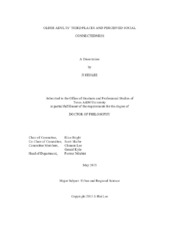| dc.description.abstract | The rapid growth of the older adult population and the preference for aging in place is a global phenomenon that will necessitate a reshaping of communities to reflect the older population’s perception and behavior. Social relationship and support in later life is important for older adults’ quality of life and health. This study aimed to identify what places American older adults frequently use for socializing and what specific characteristics of places contribute to their visit. It also examined the impact of third places on older adults’ perceived social connectedness. In this study, places that people go for socializing on regular basis outside their home were defined as third places.
The study area consisted of two cities, Bryan and College Station in Texas. The subjects were older adult homeowners who live in their own single-family homes. The randomly selected 1,150 households were visited door-to-door in Spring 2014. In total, 320 older adults participated in the study. For survey, the Pick-up and Drop-off method was used. 10% of the previous participants were revisited to check for test-retest reliability.
Controlling other variables, having a third place significantly influenced older adults’ perceived social connectedness. For older adults having a third place, the number of third places and trip frequency did not make any difference in the level of perceived social connectedness.
Third places most frequently visited by older adults were churches, restaurants/cafes, and gym/exercise places. Friendly people, atmosphere, and activities were the major contributing factors for older adults’ visits to third places. The findings of this study suggests that allowing a densely clustered, walkable places of small-scale commercial uses, especially food services, retails, and recreational facilities, in residential areas would help older adults to be more socially connected and physically independent as they age in place. | en |


